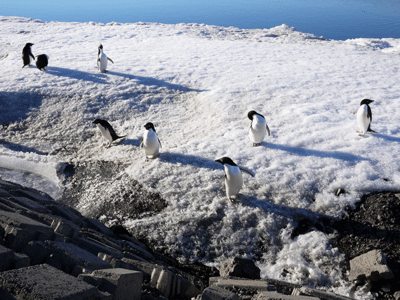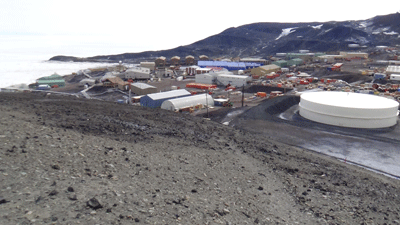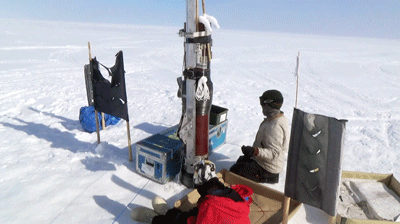- Undergraduate
- Graduate
- Undergraduate
- Graduate
- Directory
- Research Groups
- Prospective Students
- Academics
- Faculty






Panorama of Prof. Taghader's research site at Siple Dome, Antarctica.
Antarctic Adventure
It’s an honor and an exceptional opportunity to be invited to conduct research in Antarctica. It’s also a challenge for life and limb, creativity and ingenuity, as well as patience. Rapidly-changing weather can become life threatening, inhibiting travel and research plans.
The Science
Prof. Joseph Talghader became involved in a technology called “optical borehole logging” because of his interest in the Antarctica and how optics might be used to advance knowledge in glaciology—more specifically how properties of optics could be used to determine the crystal properties of glacial ice. His research is funded by the National Science Foundation.
Current methods of studying ancient ice use core samples drilled out of the ice sheets in places like Antarctica. Optical borehole logging involves sending a laser instrument down the open borehole that remains after an ice core has been drilled and using that laser to determine the dust content of the ice. As the logger is lowered deeper and deeper into the ice, if it encounters a dust layer, say produced by a volcano, the laser will scatter off of that dust and produce a spike in the light received by the logger detector. Dust signatures in the ice can range from obvious dark layers a centimeter thick, such as might come from a huge volcanic eruption, or they can be subtle features that vary over kilometers such as the dust record from glacial and interglacial cycles. A specific set of dust layers can be compared to other dust layers seen in other parts of Antarctica to produce a characteristic chronology that tells scientists how old the ice is at each depth.
Beyond dust, studying ancient ice crystals reveals more information about geological events that have occurred over the last few hundred thousand years. However, attempting crystal structure analysis with a borehole logger will require more advanced optics than a dust logger and is a primary goal of Prof. Talghader’s program. In traditional crystal studies, an ice core is pulled from the ice sheet, taken into a laboratory, sliced into sections, and placed between crossed polarizers that are illuminated by polarized light. The resulting images show irregular areas of dark and light corresponding to different crystal within the ice. (See illustration.) From this information, scientists can draw conclusions about local temperatures and ice flow from many thousands of years in the past. Currently, however, crystal data obtained from studying the ice cores can be unreliable. When the ice is taken out of the borehole, changes can occur in its structure, through bubble formation or recrystallization. These changes are due to the post-extraction loss of the surrounding ice sheet pressure.
To solve this problem, Prof. Talghader, and a graduate student, Wing Chan, teamed up with Dr. Ryan Bay of UC-Berkeley, who constructed some of the earliest optical borehole logging instruments. Dr. Bay’s devices measure dust rather than crystal structure, but before attempting to build an instrument that had the new crystal capabilities, Prof. Talghader’s group cut their teeth this field season by constructing a logger with similar capabilities to the Berkeley dust instrument but made from optical fiber to make it smaller and more lightweight.
The two researchers brought loggers built in their respective university labs; in Antarctica, they tested both and are now processing data and comparing measurements. Results so far show that where the Berkeley and Minnesota instruments overlap, there are great similarities in the data – a successful first step. Next year, Talghader and Bay will return to the Antarctic to test the Berkeley dust logger and the Minnesota crystal logger at the West Antarctic Ice Sheet (WAIS) Divide.
The Antarctic Experience
This was the scientific expedition that almost wasn’t. During the recent U.S. government shut down, Prof. Talghader wondered if it would even happen. When the budgetary dust settled, he learned the trip was on, but the destination site had been changed. WAIS Divide was the original first-year test site, but the site became a victim of government budget cuts and was closed for a year. Talghader’s team was switched to Siple Dome, a remote site that is currently used primarily as a fuel depot and emergency stopover point for planes flying over the continent. Its personnel this season consisted of only 2 persons before Talghader’s five-person team arrived (3 researchers: Talghader, Bay, and Chan, plus 2 support personnel from the USAP Drilling Office, Elizabeth Morton and Josh Goetz). Siple Dome was originally to be next season’s project research site.
In a trip that covered more than 15000 miles each way, Talghader and Wing traveled from MSP Airport in Minneapolis to Dallas to Los Angeles to Sydney, Australia to Christchurch, New Zealand to McMurdo Station, Antarctica to Siple Dome Base, Antarctica and back. The first four flights were standard commercial ones and occurred all in a row, but several days separated the commercial flights from the trips to and on the continent.

Researchers were cautioned not to interact with the penguins.
On their first day (Dec. 18) in Christchurch, New Zealand, Talghader and Wing went to the Clothing Distribution Center and were issued the Extreme Cold Weather gear (ECW) that they would use and then return at the end of their research trip. They watched orientation videos about environmental concerns and how to interact with wildlife (above) and about what conditions are like in this cold place.
Their first flight out of Christchurch towards Antarctica went straight into a 100 mile per hour head wind. After 4.5 hours, the pilot turned back. “We were flying in a Lockheed C-130 Hercules (LC-130 Herc) military transport plane that was fitted with landing skis rather than wheels,” Talghader says. “The wind, blowing out of Antarctica, was just too strong. What took 4.5 hours out, took only 2.5 hours back to Christchurch. We spent the next four days waiting for weather and mechanical issues to work themselves out before another flight actually took off. Finally on Dec. 23, we arrived near midnight at Pegasus Air Field on the Ross Ice Shelf. A giant multi-wheeled vehicle called IVAN took us to McMurdo Station (below) where we were handed our keys for the dorms. I went to the cafeteria to eat – it was open 24 hours a day.”

McMurdo Base Station, Antarctic
McMurdo accommodations are reasonably comfortable—heated dormitories and free cafeteria access. While there, Talghader had access to an office cubicle at Crary Labs to get some work done.
“We went through a number of trainings—what to do, what not to do, and how to observe but not interact with the wildlife,” Talghader says. “Then it was on to the main training session – officially called Snowcraft I but universally called “Happy Camper” by USAP participants.”
Happy Camper is located on the Ross Ice Shelf and is the place where Prof. Talghader and Ms. Chan learned to build snow walls, pitch tents on the ice, tie the correct knots to secure the tents, use a shortwave radio, and survive a white-out storm at an isolated base.
From McMurdo, transport to Siple Dome was delayed by weather, mechanical issues, and other on-continent priorities, so Talghader wrote and submitted a white paper he had been preparing. “Good thing I submitted it then,” he says. “When we finally returned from Siple Dome, it was 8 days later than we expected, and the paper would have been many days late!”
On Jan. 3, the team was transported to Simple Dome on a LC-130. “We packed a few sandwiches and were off on a two-hour flight to the research site.” Besides Ryan, Wing, and Talghader, two drilling specialist accompanied the team—Josh Goetz and Elizabeth Morton—who were going to test a new winch system at the site.
Simple Dome living conditions were simple. A heated “rack tent” (about 20 x 20 ft.) served as a kitchen and dining “hall”. Each member of the research group had his or her own one-person-tent for sleeping on the ice sheet. The team subsisted on decade-plus-old food supplies that had been stored in a freezer space dug into the ice sheet. “You can definitely eat food many years past its expiration date without getting sick,” Talghader says. “We had essentially no fresh food, but otherwise we ate well - Thai chicken curry, lobster tails, whatever we could dream up from the ingredients and supplies that had been laid down many years before.
“Upon arrival, we unloaded our equipment and met the Siple site team, Dan and Cricket, husband and wife, who were taking care of the camp during the summer. They showed us the two-rack tents, the snowmobiles we’d be using, and the locations of unstable ground. Then we went out to the borehole, which was about two miles from camp, and set up a tent near it for our scientific equipment. We checked out an automated weather station that was about a mile from the borehole and then went back to camp.” For the next five days, the team worked outside every day. It was beautiful blue-sky weather with 10-20 degrees Fahrenheit temperatures.

Testing the optical borehole loggers at Siple Dome
Prof. Bay set up his logger in a day and a half and tested it for a day. His logger was fairly large but had been used in many boreholes before and was easy to use. Talghader’s equipment, designed for the WAIS Divide borehole, had to be reworked to fit into the smaller Siple Dome borehole.
“I was glad we had a site to ourselves because we weren’t in anyone’s way while we retooled the logger. As we yanked off the protruding stabilizing arms to make the diameter of our logger smaller, Ryan let us borrow some of his mechanical supports to make sure that our logger stayed in the center of the hole. We completed our testing the next day. Our results were very good; we went down about 250-300 meters. Ryan’s data and our data exhibited similar features with few differences even though the wavelengths of our lasers were very different. Light from his logger scatters many times in the ice while ours scatters once, or at most a few times, before being absorbed. Even though we had trouble adapting the logger to Siple instead of WAIS after the shutdown, eventually we got everything to work well.”
The team had a late lunch on that last day of testing (the sixth day) and prepared to leave the site. As the fog began to roll in, they quickly took down the logger tent and transported all the equipment back to the Siple Dome base camp. The flight to take them back to McMurdo was supposed to arrive the next day, but storms rolled in and between weather and organizational issues, it was eight days before they could be transported out.
To pass the time, Talghader worked on a proposal, prepared meals with the team, and completed tasks around the base (shoveling out the fuel bladders and packing pallets with equipment for transport.) “It was pretty boring; we had no internet access and our only connection to the outside world was a satellite phone. But I did find an old novel someone with a sense of humor had left behind on a shelf—H. P. Lovecraft’s At the Mountains of Madness, which is an Antarctic horror story where an expedition discovers the ruins of an ancient non-human civilization and, of course, most of the expedition dies off before the leader finds even greater horrors buried in the ice. That helped pass the time. We finally left Siple Dome on Jan. 17 rather than Jan 9. Dan and Cricket told us that the weather while we were performing experiments was the best they’d had all season. The storms and fog while we were waiting to leave was much more typical. Siple has a reputation of having some of the worst weather on the continent.”
The team returned to McMurdo and within two days flew to New Zealand and returned their ECW without incident. Next year, two researchers from Minnesota will return to Antarctica to test a newly build crystal structure logger at the WAIS Divide site.